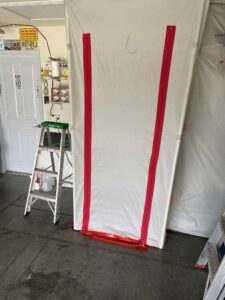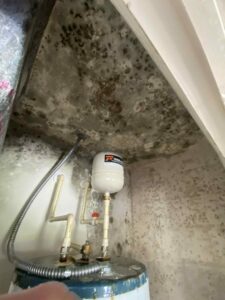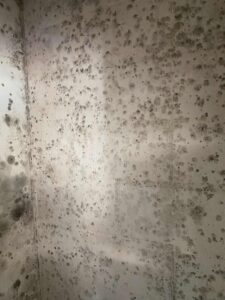We specialize in medically sensitive remediation and restoration services. Our team is trained to serve clients with compromised immune systems, CIRS, asthma, and other respiratory sensitivities.
Our Mold Remediation process is tailored to protect health-compromised individuals and their indoor air quality.
Our Mold Remediation Process
In 5 (And A Half) Steps
What To Expect When You Hire Us
Step #1:
Containing The Mold:
Remediation kicks up thousands of mold spores. If those mold spores aren’t confined to the
containment area, they will spread to the rest of your home. Not good! Our containment process stops mold spores from escaping the project area. The mold remains confined to the contained area and only the contained area. Period.
Step #2:
Setting Up Air Filtration Devices:
Next, we put in an Air Filtration Device (AFD), which has two purposes…
To run as a Negative Air Machine (NAM) during the demolition phase to creative negative air pressure
To run as an Air Scrubber during the cleaning phase
AFDs come in all sizes and strengths. To match your house with the right machine, we calculate the cubic footage of air in the containment for setting up air scrubbers. For negative air pressure, however, we have to measure the pressure with the manometer (the cubic footage calculations aren’t reliable here because there are openings and gaps in walls, windows, etc.).
Step #3:
Removing The Mold:
This is the demolition phase. All the moldy porous materials that can’t be saved get cut out and removed: carpet, drywall, insulation, and so on. If we have to walk through your home with the trash, then we use a special method of tying the trash bags (called “goosenecking”) that prevents mold spores from escaping All the moldy materials that can be saved (like wood framing, subfloor, plaster, etc.) get sanded, wire brushed, or blasted. The method depends on the surface and how much is moldy. This stripping is needed because mold grows roots into the surface. We must strip a thin layer off the surface to remove the mold colony and its roots, much like a dentist cleaning out a cavity. Before doing any demolition, we take a long and hard look at your situation to ensure the
most efficient, cost-effective, and practical way to solve your mold problem. We seriously consider the balance between cost, safety, and doing the job properly.
Step #4:
Intensive, Chemical-FREE Cleaning:
This is one of the most important parts of the process… and when we get fanatical about cleanliness. First, we HEPA vacuum the walls, baseboard, and floor one square inch at a time. Since we can’t see mold spores, we must assume they’re everywhere, so every surface in the containment needs to be vacuumed. Next, we damp wipe the top of every pipe, wire, duct, door frame, baseboard, and window frame. These areas accumulate mold spores too and can’t be vacuumed easily. We damp wipe in a VERY specific way. The towel is folded into squares and each surface is only used once so we don’t pick up mold from one surface and wipe it onto another. For mold-sensitized clients, we also damp wipe the ceiling, walls, and floor in our containment. To give you a sense of how thoroughly we clean the area, we’ve done many sensitive projects that were tested and met Cleanroom Standards. This means there is so little dust that NASA could build a satellite or Intel could manufacture computer chips in our containment areas!
Step #5:
Putting The Area Back Together:
If we do have to take out materials, we can help restore the area—either by repairing it ourselves or referring you to one of our trusted home-improvement partners. Either way, it will look like it never got cut out in the first place.
Bottom line: We make the mold-remediation process as painless as possible. You won’t find another mold remediation company in the Southeast that takes the time to educate their customers and ensure the job is done 100% right.
Step #5 1/2:
Chemical Treatment (Rare):
We make a big deal about being one of the few chemical-free mold remediators in the southeast. Yet we use certain chemicals in about 10% of jobs. Wait… what? We’ll explain. The national mold remediation standard (AKA S520) says chemicals can be used after proper remediation has been completed. So, if you want a mold stain removed? Or wood framing encapsulated with mold-inhibiting paint to protect it? That’s fine. We do not use chemicals to kill mold. (See why on our No Chemicals page.) Since there is a 90% chance your job won’t need chemicals, we don’t count this as a “full” Step in our process. But if your project does require them, we’ll explain why upfront.



